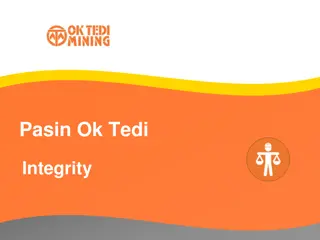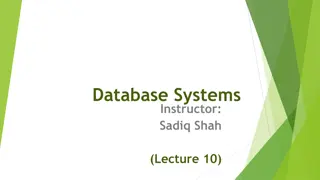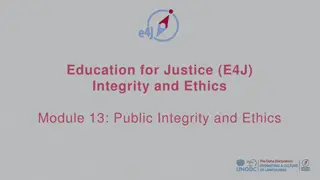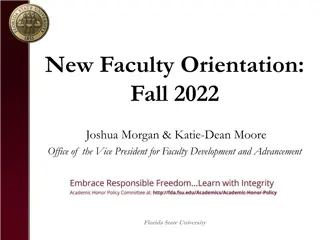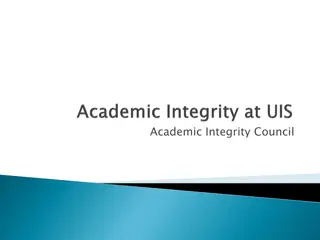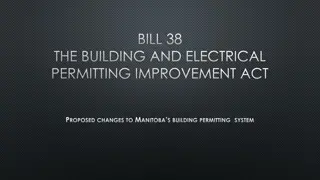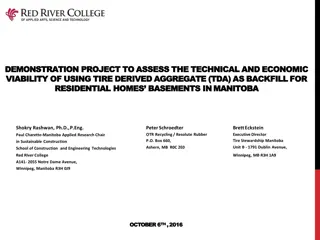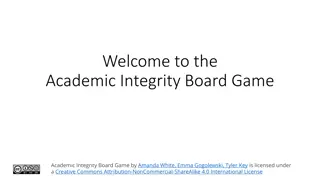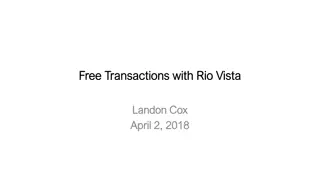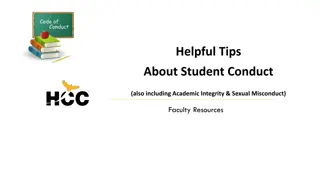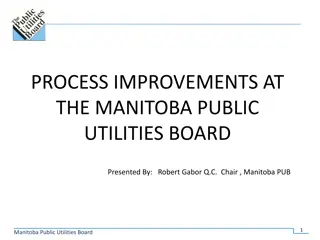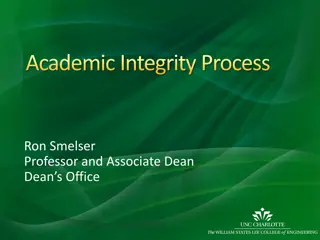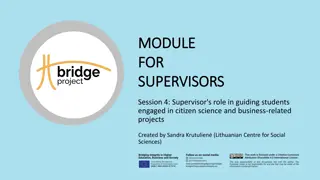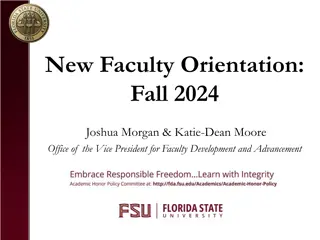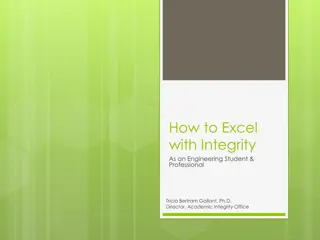Understanding Academic Integrity at the University of Manitoba
Explore the essential aspects of academic integrity, including its definition, importance for students, types of dishonesty, and expectations in a class setting. Discover why students should care about academic integrity, the various types of academic misconduct such as plagiarism and cheating, and how to maintain ethical standards in coursework. Get insights on where students can find more information and resources on academic integrity.
Download Presentation

Please find below an Image/Link to download the presentation.
The content on the website is provided AS IS for your information and personal use only. It may not be sold, licensed, or shared on other websites without obtaining consent from the author. Download presentation by click this link. If you encounter any issues during the download, it is possible that the publisher has removed the file from their server.
E N D
Presentation Transcript
Academic Integrity An important conversation
Questions to discuss with students What is academic integrity? Why should students care about academic integrity? What are the various types of academic dishonesty? What are the expectations in this class? Where can students go for more information? umanitoba.ca
What is academic integrity? umanitoba.ca 4
What is academic integrity? Integrity What is academic integrity? adherence to moral and ethical honesty in coursework and principles research soundness of moral character honesty (dictionary.com) umanitoba.ca
Academic Integrity academicintegrity.org umanitoba.ca
Why should students care about academic integrity? umanitoba.ca
Why should students care about academic integrity? Eliminates unfair advantage between students Foundation of your university degree Gives your degree value Builds moral character Prepares students for future life and work demands umanitoba.ca
What are the various types of academic misconduct? umanitoba.ca
Inappropriate collaboration Plagiarism Cheating Duplicate submission Personation Academic Fraud umanitoba.ca 10
the presentation or use of information, ideas, sentences, findings, etc. as one s own without appropriate citation in a written assignment, test or final examination. Plagiarism This definition is located in the Student Academic Misconduct Procedure. umanitoba.ca 11
Copying text (even if from the instructor s notes or course textbook) verbatim, without including it in quotation marks and citing the source. Examples of Plagiarism Copying non-written media (e.g., part of or entire diagrams, tables, graphs, maps, images, pictures, or photos) without proper referencing or permissions. Copying sentences and changing some words without proper citation or acknowledging the source of the ideas or information. Presenting an idea, summary of information, etc., without acknowledging the source of those ideas or information. Source: These examples were compiled by members of the Academic Integrity Working Group (AIWG) and Associate Dean s representing various faculties, using experiences and documents from the Office of Student Advocacy as resources for their preparation. umanitoba.ca 12
the circumventing of fair testing procedures or contravention of exam regulations. Such acts may be premeditated/planned or may be unintentional or opportunistic. Cheating This definition is located in the Student Academic Misconduct Procedure. umanitoba.ca 13
Looking at another student s paper or screen during an examination. Examples of Cheating Allowing other students to view/use answers during a test or examination. Possession of unauthorized materials in the examination room that could help performance on the exam. Source: These examples were compiled by members of the Academic Integrity Working Group (AIWG) and Associate Dean s representing various faculties, using experiences and documents from the Office of Student Advocacy as resources for their preparation. umanitoba.ca 14
When a student and any other unauthorized person work together on assignments, projects, Inappropriate collaboration tests, labs or other work unless authorized by the course instructor. This definition is located in the Student Academic Misconduct Procedure. umanitoba.ca 15
Seeking substantial help or working together on part or all of an assignment of any sort - without permission. Students are encouraged to carefully read assignment instructions and to ask their instructor if at all unsure about the rules on collaboration for any assignment, quiz, lab or test. Having someone proofread a paper for language correctness is not considered inappropriate collaboration, if permission is sought from the instructor before doing so. Proofreader is not to help with the academic content of the paper. Examples of Inappropriate collaboration Dishonest use of old assignments and tests for the purpose of completing new assignments, e.g., stealing tests from examination rooms, distributing exams when told not to do so. Source: These examples were compiled by members of the Academic Integrity Working Group (AIWG) and Associate Dean s representing various faculties, using experiences and documents from the Office of Student Advocacy as resources for their preparation. umanitoba.ca 16
cheating where a student submits a paper, assignment, or test in full or in part, for more than one course without the permission of the course instructor. Plagiarism Duplicate submission This definition is located in the Student Academic Misconduct Procedure. umanitoba.ca 17
Submitting a paper written and graded for another course. Examples of duplicate Duplicate Examples of Examples of Plagiarism submission submission Submitting data, images, diagrams, tables or maps that were completed for another course without proper citation and without permission from the instructor. Submitting labs or other assignments written or graded for the same or another course. Source: These examples were compiled by members of the Academic Integrity Working Group (AIWG) and Associate Dean s representing various faculties, using experiences and documents from the Office of Student Advocacy as resources for their preparation. umanitoba.ca 18
writing an assignment, lab, test, or examination for another student, or the unauthorized use of another person s signature or identification in order to impersonate someone else. Personation includes both the personator and the person initiating the personation. Personation This definition is located in the Student Academic Misconduct Procedure. umanitoba.ca 19
Writing a paper, assignment or lab for another student. Examples of personation Personation Attending and writing a test or examination for another student. Examples of Use of false identification or a fake signature of another person to write an examination or obtain services from the university. Recording attendance for another student. Source: These examples were compiled by members of the Academic Integrity Working Group (AIWG) and Associate Dean s representing various faculties, using experiences and documents from the Office of Student Advocacy as resources for their preparation. umanitoba.ca 20
falsification of data or official documents as well as the falsification of medical or compassionate circumstances/ documentation to gain accommodations to complete assignments, tests or examinations. Academic Fraud This definition is located in the Student Academic Misconduct Procedure. umanitoba.ca 21
Submitting false material for assignment or lab (i.e., made-up data). Examples of Academic Fraud Purchasing a term paper or assignment or paying someone to prepare it (having someone proofread is excluded, unless prohibited by instructor). Using a website or social media site to dishonestly complete a paper, assignment or lab. Source: These examples were compiled by members of the Academic Integrity Working Group (AIWG) and Associate Dean s representing various faculties, using experiences and documents from the Office of Student Advocacy as resources for their preparation. umanitoba.ca 22
What are the expectations in this course? umanitoba.ca 23
What is appropriate in my class: Discussion of assignment with other students Brainstorming with classmates Peer editing Asking for clarification on assignment requirements Seeking help on how to cite sources umanitoba.ca
What is not appropriate: Submitting any amount of work written by someone else Using ideas, facts, or phrases from someone else without citing Submitting work that you submitted in another class umanitoba.ca
Where can students get more information? umanitoba.ca 26
University of Manitoba Resources Academic Learning Centre UM Libraries Student Advocacy Student Conduct: Your Rights and Responsibilities UM Academic Calendar Instructor Course Syllabus Insert Your Office Hours Information umanitoba.ca



